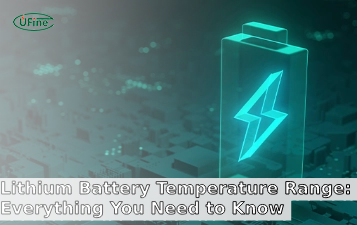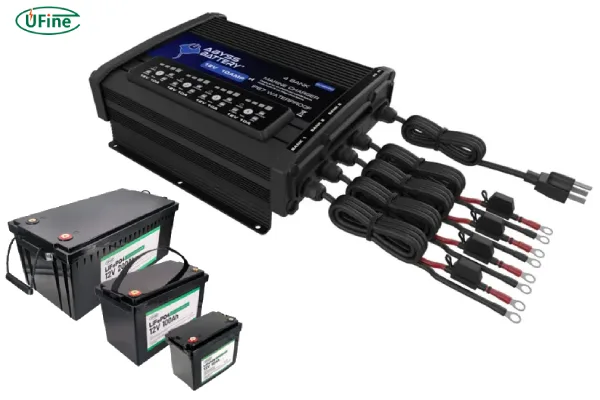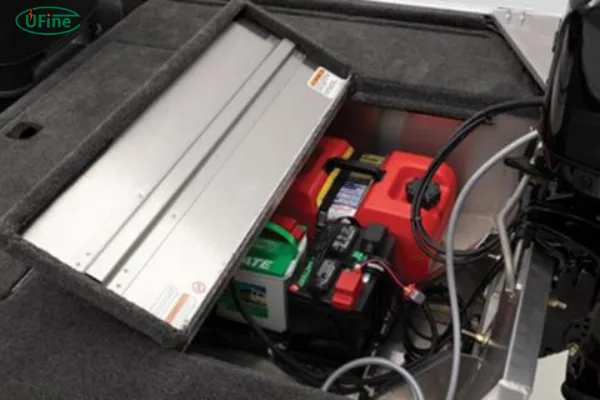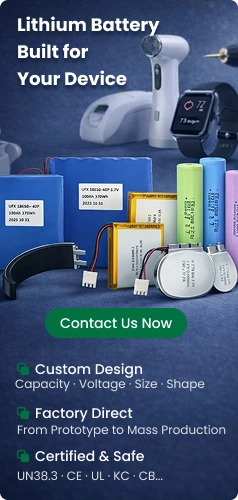
- Part 1. What functions does a boat battery charger need?
- Part 2. Boat battery chargers types
- Part 3. Key parameters of boat battery chargers
- Part 4. What charging cable does a boat battery charger need?
- Part 5. How to charge the battery with a boat battery charger?
- Part 6. Boat battery charger maintenance tips
- Part 7. Final words
If you own a boat, keeping the battery charged is essential for ensuring your trip goes smoothly. Having the right boat battery charger is crucial for maintaining the performance and longevity of your boat’s battery. But with so many options available, how do you choose the best one? In this article, we’ll explore what functions to look for in a boat battery charger, the different types, and tips for proper maintenance to keep your charger working effectively.
Part 1. What functions does a boat battery charger need?
When selecting a boat battery charger, there are several important functions to consider. A quality charger should be more than just a simple power source—it should offer features that protect your battery and optimize charging.
Key Functions Include:
-
Automatic Charging:
Look for a charger that automatically switches from charging to maintenance mode. This prevents overcharging, which can damage the battery over time. -
Multi-Bank Charging:
If your boat uses multiple batteries, a charger with multi-bank functionality allows you to charge multiple batteries simultaneously. This is especially useful for boats with both starting and deep cycle batteries. -
Waterproofing:
Since boats are exposed to water and moisture, it’s important that your charger is waterproof or at least water-resistant. This ensures durability and longevity. -
Temperature Compensation:
Batteries can be affected by extreme temperatures. A charger with temperature compensation adjusts the charging rate to prevent overheating in hot weather or undercharging in cold conditions. -
Reverse Polarity Protection:
This function ensures that the charger won’t work if the cables are connected incorrectly. It’s a safety feature that helps prevent accidents and damage to your battery. -
Trickle Charge or Maintenance Mode:
Once the battery is fully charged, the charger should switch to a trickle charge mode to maintain the battery without overcharging it. -
Battery Type Compatibility:
Ensure the charger can work with your specific battery type, whether it’s a lead-acid, AGM, or lithium battery. Some chargers are universal and support multiple battery types.
Part 2. Boat battery chargers types
There are several types of boat battery chargers, each suited for different needs. Here are the main types:
Onboard Chargers:
These are permanently installed in the boat and are convenient because you don’t have to remove the battery to charge it. Just plug in the charger, and it will take care of the rest. Onboard chargers are designed to handle marine environments, so they’re durable and reliable.
Portable Chargers:
Portable chargers are more flexible because you can move them from one battery to another. They’re not fixed to the boat and are perfect for boaters with multiple boats or other vehicles, like RVs or golf carts.
Solar-Powered Chargers:
If you’re looking for an eco-friendly option, solar-powered chargers use sunlight to charge your boat’s battery. They are often used as maintenance chargers to keep the battery topped off when the boat is not in use.
Smart Chargers:
Smart chargers are advanced units that monitor the battery’s health and adjust the charging process based on the battery’s condition. They are ideal for keeping batteries in peak condition and extending their lifespan.
Part 3. Key parameters of boat battery chargers
When choosing a boat battery charger, you need to pay attention to several key parameters to ensure it meets your boat’s needs. These parameters will directly affect the charger’s performance and compatibility with your battery system.
1. Amperage (Amp Rating):
The amperage determines how quickly the charger can charge your battery. Higher amps charge faster, but you need to match the charger’s amperage to your battery’s capacity to avoid overloading it.
2. Voltage Compatibility:
Make sure the charger matches your boat’s battery voltage (e.g., 12V, 24V, or 36V). Using the wrong voltage can damage the battery or the charger.
3. Battery Type Support:
Not all chargers are compatible with every battery type. Ensure your charger supports the type of battery you’re using—be it flooded lead-acid, AGM, or lithium.
4. Waterproof Rating (IP Rating):
Look for a charger with a high IP rating, indicating its resistance to water and dust. An IP rating of at least IP65 is recommended for marine environments.
5. Charging Time:
Consider how long it takes for the charger to fully charge your battery. Faster chargers may have a higher amperage, but slower chargers can be gentler on the battery for long-term maintenance.
6. Portability and Size:
If you’re choosing a portable charger, consider its size and weight. You’ll want something compact if space on your boat is limited.
7. Safety Features:
Ensure the charger has built-in safety features like overload protection, short-circuit protection, and reverse polarity protection to avoid accidents.
Part 4. What charging cable does a boat battery charger need?
The charging cable you use is just as important as the charger itself. Make sure the cable is:
-
Marine-Grade: Marine-grade cables are designed to withstand harsh marine conditions, including exposure to saltwater and UV rays.
-
Proper Gauge: The thickness of the cable (gauge) must match the current flow. Thicker cables (lower gauge numbers) are needed for high-amperage chargers to avoid voltage drops.
-
Long Enough: Choose a cable length that provides enough reach between your battery and the charger. Too short a cable can be inconvenient, while too long can lead to power loss.
Always double-check that the charging cables are compatible with both your charger and battery terminals.
Part 5. How to charge the battery with a boat battery charger?
Charging a boat battery with a charger is a simple process if done correctly. Here’s a step-by-step guide:
-
Turn Off the Boat: Before connecting the charger, make sure all electrical systems on the boat are turned off.
-
Connect the Charger to the Battery: Attach the positive cable (red) to the positive terminal and the negative cable (black) to the negative terminal. If your charger has clamps, ensure they are securely attached.
-
Select the Appropriate Charging Mode: If your charger has different settings for different battery types (AGM, lead-acid, or lithium), select the correct one.
-
Turn On the Charger: Once everything is connected, plug in the charger and turn it on. The charger should begin charging the battery.
-
Monitor the Charging Process: Many modern chargers will show the charging status on an LED display. Keep an eye on the progress and ensure it switches to maintenance or trickle mode when the battery is fully charged.
-
Disconnect the Charger: After charging is complete, turn off the charger and remove the cables from the battery. Ensure everything is secure and properly stored.
Part 6. Boat battery charger maintenance tips
To ensure your boat battery charger lasts and performs well over time, regular maintenance is essential. Here are a few tips to keep your charger in top condition:
-
Inspect Regularly: Check for any signs of wear, damage, or corrosion on the cables and connectors. Replace any damaged components immediately.
-
Keep It Clean: Wipe down the charger to remove dirt, grime, or moisture. This is especially important if your charger is not waterproof.
-
Store Properly: When not in use, store your charger in a dry and cool place to avoid exposure to moisture and extreme temperatures.
-
Check the Cables: Ensure that your charging cables are not frayed or damaged. Faulty cables can lead to poor charging or even dangerous conditions.
-
Use the Right Charger: Always use a charger that is compatible with your battery type and voltage. Mismatched chargers can reduce battery life or cause damage.
Part 7. Final words
Choosing the right boat battery charger is essential for maintaining your boat’s battery health and ensuring your electronics function reliably. Whether you opt for an onboard charger, portable charger, or smart charger, it’s crucial to consider the functions, types, and key parameters that best meet your boat’s needs. Proper maintenance and the right charging practices will keep your boat batteries in optimal condition for years to come.
Related Tags:
More Articles

Lithium Battery Temperature Range: Everything You Need to Know
Lithium battery temperature ranges for operation, charging, and storage, including maximum limits, performance impact, and safety risks.
XT60 vs. XT90 Battery Connector Comparison
Compare XT60 and XT90 connectors for drones, EVs, and industrial devices. Learn features, pros/cons, current capacity, and anti-spark options.
Lithium-ion vs Lithium Polymer Battery: Which is Better?
Compare lithium-ion and lithium polymer (LiPo) batteries: lifespan, safety, energy density, and best uses for drones, laptops, and wearables.
How Much Does a Car Battery Weigh?
Find out how much different car batteries weigh, how to calculate the right one, and tips to optimize performance and efficiency for your vehicle.
Lithium Battery Protection Board: Function, Circuit, PCB vs BMS
A practical guide to lithium battery protection boards, protection circuits, and when to use PCB, PCM, or a battery BMS in real applications.




